Principles of Economics 附赠Solution Chapter 01
principles of economics 10th edition pdf
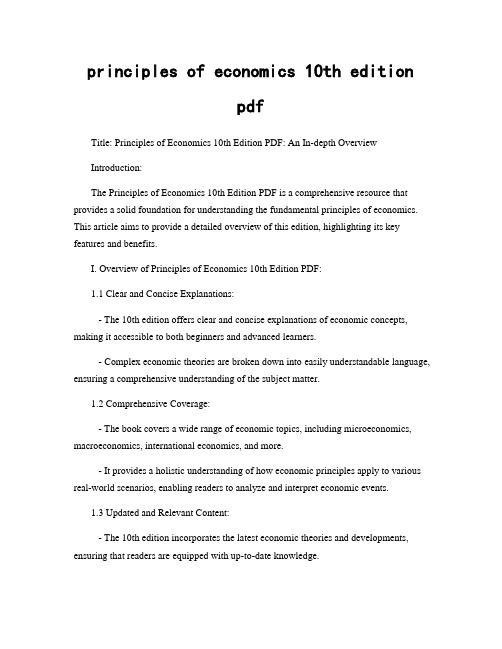
principles of economics 10th editionpdfTitle: Principles of Economics 10th Edition PDF: An In-depth OverviewIntroduction:The Principles of Economics 10th Edition PDF is a comprehensive resource that provides a solid foundation for understanding the fundamental principles of economics. This article aims to provide a detailed overview of this edition, highlighting its key features and benefits.I. Overview of Principles of Economics 10th Edition PDF:1.1 Clear and Concise Explanations:- The 10th edition offers clear and concise explanations of economic concepts, making it accessible to both beginners and advanced learners.- Complex economic theories are broken down into easily understandable language, ensuring a comprehensive understanding of the subject matter.1.2 Comprehensive Coverage:- The book covers a wide range of economic topics, including microeconomics, macroeconomics, international economics, and more.- It provides a holistic understanding of how economic principles apply to various real-world scenarios, enabling readers to analyze and interpret economic events.1.3 Updated and Relevant Content:- The 10th edition incorporates the latest economic theories and developments, ensuring that readers are equipped with up-to-date knowledge.- It includes real-world examples and case studies to illustrate economic concepts, making the content relevant and engaging.II. Key Features of Principles of Economics 10th Edition PDF:2.1 Interactive Learning Tools:- The edition offers interactive learning tools, such as online quizzes, practice exams, and additional resources, enhancing the learning experience.- These tools allow readers to assess their understanding, reinforce key concepts, and apply their knowledge to practical situations.2.2 Graphical Representation:- The book extensively uses graphs and charts to visually represent economic concepts, facilitating better comprehension and retention.- Graphical representations help readers visualize economic relationships and analyze data effectively.2.3 In-depth Analysis:- The 10th edition provides in-depth analysis of economic theories, enabling readers to grasp the underlying principles and their implications.- It encourages critical thinking and helps readers develop a deeper understanding of economic concepts.III. Benefits of Principles of Economics 10th Edition PDF:3.1 Practical Application:- The book emphasizes the practical application of economic principles, equipping readers with the skills to analyze and solve real-world economic problems.- It provides insights into economic decision-making, enabling readers to make informed choices in their personal and professional lives.3.2 Enhanced Problem-Solving Skills:- The 10th edition includes numerous problem-solving exercises and case studies, allowing readers to apply economic principles to analyze and solve complex problems.- By engaging in these exercises, readers develop critical thinking and problem-solving skills essential for success in the field of economics.3.3 Versatility:- The Principles of Economics 10th Edition PDF is suitable for a wide range of readers, including students, professionals, and individuals interested in understanding economics.- Its comprehensive coverage and accessible language make it an invaluable resource for anyone seeking to gain a solid understanding of economic principles.Conclusion:The Principles of Economics 10th Edition PDF is a highly valuable resource that offers clear explanations, comprehensive coverage, and updated content. Its interactive learning tools, graphical representation, and in-depth analysis contribute to an enhanced learning experience. By emphasizing practical application and problem-solving skills, this edition equips readers with the knowledge and abilities necessary to navigate the complex world of economics. Whether you are a student or a professional, this edition is an essential tool for mastering economic principles.。
商业经济学英文教材
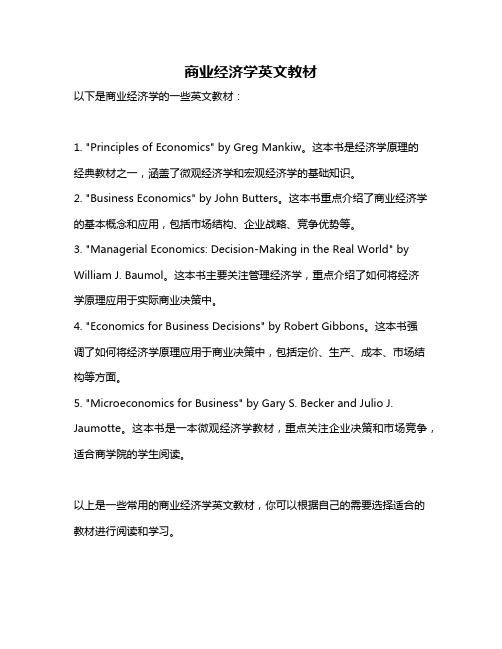
商业经济学英文教材
以下是商业经济学的一些英文教材:
1. "Principles of Economics" by Greg Mankiw。
这本书是经济学原理的
经典教材之一,涵盖了微观经济学和宏观经济学的基础知识。
2. "Business Economics" by John Butters。
这本书重点介绍了商业经济学的基本概念和应用,包括市场结构、企业战略、竞争优势等。
3. "Managerial Economics: Decision-Making in the Real World" by William J. Baumol。
这本书主要关注管理经济学,重点介绍了如何将经济
学原理应用于实际商业决策中。
4. "Economics for Business Decisions" by Robert Gibbons。
这本书强
调了如何将经济学原理应用于商业决策中,包括定价、生产、成本、市场结构等方面。
5. "Microeconomics for Business" by Gary S. Becker and Julio J. Jaumotte。
这本书是一本微观经济学教材,重点关注企业决策和市场竞争,适合商学院的学生阅读。
以上是一些常用的商业经济学英文教材,你可以根据自己的需要选择适合的教材进行阅读和学习。
10版经济学原理
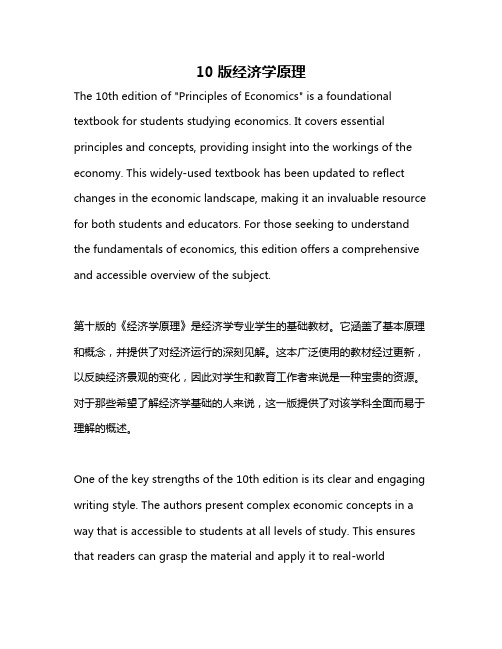
10版经济学原理The 10th edition of "Principles of Economics" is a foundational textbook for students studying economics. It covers essential principles and concepts, providing insight into the workings of the economy. This widely-used textbook has been updated to reflect changes in the economic landscape, making it an invaluable resource for both students and educators. For those seeking to understand the fundamentals of economics, this edition offers a comprehensive and accessible overview of the subject.第十版的《经济学原理》是经济学专业学生的基础教材。
它涵盖了基本原理和概念,并提供了对经济运行的深刻见解。
这本广泛使用的教材经过更新,以反映经济景观的变化,因此对学生和教育工作者来说是一种宝贵的资源。
对于那些希望了解经济学基础的人来说,这一版提供了对该学科全面而易于理解的概述。
One of the key strengths of the 10th edition is its clear and engaging writing style. The authors present complex economic concepts in a way that is accessible to students at all levels of study. This ensures that readers can grasp the material and apply it to real-worldsituations, enhancing their understanding of economic principles. By making the content engaging and easy to follow, the textbook effectively supports students' learning and encourages them to explore economics further.第十版的一大优点是其清晰而引人入胜的写作风格。
807经济学基础参考书目

807经济学基础参考书目经济学是一门研究资源配置和决策制定的学科,涉及到各个领域的经济活动。
以下是一些经济学基础参考书目,这些书籍涵盖了经济学的核心概念、理论和方法,适合初学者和进阶学习者。
1. 《经济学原理》(Principles of Economics)- N. Gregory Mankiw这本书是经济学入门的经典教材,涵盖了微观经济学和宏观经济学的基本原理。
它以清晰的语言和实际案例解释了经济学的核心概念,适合初学者。
2. 《经济学》(Economics)- Paul Samuelson和William Nordhaus这本书是经济学领域的经典教材,被广泛用于大学本科经济学课程。
它详细介绍了经济学的各个方面,包括微观经济学、宏观经济学和国际经济学。
3. 《经济学原理》(Economics: Principles and Policy)- William J. Baumol 和Alan S. Blinder这本书以实际案例和政策分析为基础,介绍了经济学的基本原理和政策应用。
它涵盖了微观经济学和宏观经济学的主题,适合对经济学感兴趣的读者。
4. 《经济学:一门科学的思维方式》(Economics: The Science of Common Sense)- David A. Anderson和Dennis J. Sweeney这本书以实际案例和经济学原理为基础,介绍了经济学的基本概念和思维方式。
它强调了经济学在日常生活中的应用,适合初学者。
5. 《经济学:一门科学的思维方式》(Economics: A Contemporary Introduction)- William A. McEachern这本书以实际案例和经济学原理为基础,介绍了经济学的基本概念和方法。
它强调了经济学在现代社会中的应用,适合初学者。
6. 《经济学:原理与政策》(Economics: Principles and Policy)- William J. Baumol和Alan S. Blinder这本书详细介绍了经济学的基本原理和政策应用。
曼昆微观经济学经济学十大原理 英文版
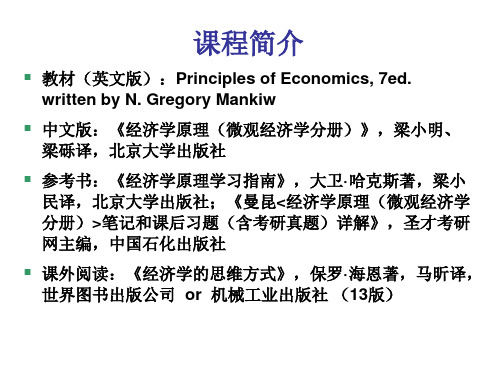
1
CHAPTER
1
Ten Principles of Economics (经济学十大原理)
Economics
PRINCIPLES OF
N. Gregory Mankiw
© 2015 CUFE
In this chapter, look for the answers to these questions:
边际是高等数学微分的概念;理性人决策:边际收益>边际成
本(Do);边际收益<边际成本(Undo)
13
HOW PEOPLE MAKE DECISIONS
Principle #3: 理性人考虑边际量
Rational People Think at the Margin Exampconsiders whether to go to
HOW PEOPLE MAKE DECISIONS
Principle #2: 某种东西的成本是为了得到它而放弃的东西
The Cost of Something Is What You Give Up to Get It
Making decisions requires comparing the costs and
7
Society faces an important tradeoff:
HOW PEOPLE MAKE DECISIONS Principle #1: 人们面临权衡取舍
效率 (efficiency) vs. 平等 (equality)
Efficiency: 社会能从稀缺资源获得最大利益的特性 . when
college for an additional year, he compares the fees & foregone wages to the extra income he could earn with the extra year of education.
Principles of Economics
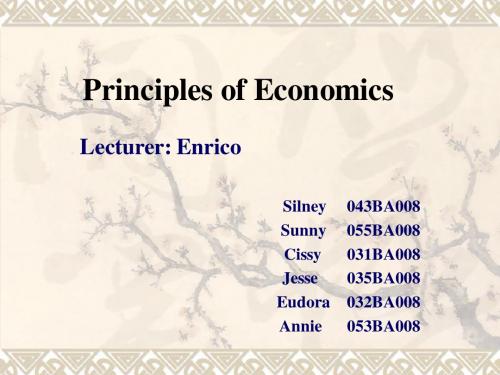
Question 3(2)
The foreign exchange market transaction subjects were overconcentrated, trading tool single problem in China .Currently inter-bank foreign exchange market mainly by the state-owned commercial Banks joint-equity commercial Banks, foreignfunded financial institutions approved, a high credit Banks and non-bank financial institutions From the turnover Bank of China's largest seller of foreign exchange ,The people's bank of China is the biggest foreign buyers , Both sides of total trading volumes of 60%.
Question 4(1)
U.S. is a very important market for China. And if China doesn’t appreciate its currency it might lost its assess to the US market. For one thing, perhaps this comment is correct. Each country all want to protect native industry to develop and market share, usually through various economical ways to restrict imports, such as America. Chinese products due to cost-effective higher, currently holds the United States more market share. America in order to protect native economic, ask China to appreciate RMB. Chinese government in a variety of pressure, in order to incompletely lost to the United States market, the largest market. China has to appreciate its currency.
名著导读 Principles of Ecomomics

Principles of Economics[America]N.Gregory MankiwPurpose of recommending book:With its clear and engaging writing style, Principles ofEconomics has become the most popular and widely usedeconomics textbook among today’s students during the pastyears. In the book, the author emphasizes material that you arelikely to find interesting about the economy(particular if youare studying economics for the first time),including real-lifescenarios,useful facts, and the many ways economic conceptsplay a role in the decisions you make every day. Principles ofEconomics is essential reading for all students takingintroductory economics modules on undergraduate coursesthroughout the world and will be of interest to studentsstudying economics all over the world. It is also ideal for usewith the economics component of MBA courses.Key features:*The book is available with the most advanced new products for student and instructor choice, engagement, and outcomes. The latest edition contains extensively updated coverage of areas impacted by the financial crisis.*Premium PowerPoint® Presentations feature chapter-by-chapter slides designed to make it more effective for learners to study. The website link is attached to the book.*In the book, the text contains numerous Case Studies to vividly illustrate the real-world applications and consequences of key principles.*"Quick Quizzes" follow each major section to help students check their comprehension of what they just learned.*Each chapter contains a variety of problems and applications that encourage students to apply the material they have learned. These practical, interesting activities serve equally well as homework assignments and starting points for lively discussions.Biography of the writer:N. Gregory Mankiw is Professor of Economics at Harvard University. He has written two popular textbooks--the intermediate-level textbook Macroeconomics (Worth Publishers) and the introductory textbook Principles of Economics (South-Western/Thomson). Additionally, he has published dozens of scholarly articles as well as articles in more popular media such as The New York Times, Fortune Magazine and The Wall Street Journal. In addition to his writing, Professor Mankiw has been a research associate of the National Bureau of Economic Research, an adviser to the Federal Reserve Bank of Boston and the Congressional Budget Office, and a member of the ETS test development committee for the advanced placement exam in economics. From 2003 to 2005 he served as Chairman of the President's Council of名著导读Economic Advisers.Greg Mankiw currently resides in Wellesley, Massachusetts with his wife Deborah, and their three children, Catherine, Nicholas, and Peter.The structure of the book:PART I: INTRODUCTIONPART II: HOW MARKETS WORKPART III: MARKETS AND WELFAREPART IV: THE ECONOMICS OF THE PUBLIC SECTORPART V: FIRM BEHA VIOR AND THE ORGANIZATION OF INDUSTRYPART VI: THE ECONOMICS OF THE LABOR MARKETPART VII: TOPICS FOR FURTHER STUDYPART VIII: THE DATA OF MACROECONOMICSPART IX: THE REAL ECONOMY IN THE LONG RUNPART X: MONEY AND PRICES IN THE LONG RUNPART XI: THE MACROECONOMICS OF OPEN ECONOMICSPART XII: SHORT-RUN ECONOMIC FLUCTUA TIONSPART XIII: FINAL THOUGHTSThe tips from the Journal of Financial studies:1.The writer has used various learning tools that recur throughout the book, including case studies, the news boxes, FYI boxes, Definitions of key concepts, Quick quizzes, Chapter summaries, List of key concepts, Questions for review, Problems and applica tions. so, you’d better take advantage of these sections, which will help you learn the fundamental lessons of economics as well as apply these lessons to your lives and to the world in which you live.2.The book is one of five versions of this book that are available for introducing students to economics. The other versions are: Principles of Microeconomics, Principles of Macroeconomics, Brief Principles of Macroeconomics, and Essentials of Economics. If possible, you can make a try to read the books above, and it will be good supplements for your study.3.Cengage South-Western offers various supplements for instructors and students who use this book. These resources make teaching the principles of economics easy for the professor and learning them easy for the student, and a list of available supplements follows the preface of the book.Reference Bibliography1[美]N.Gregory Mankiw著Essentials of Economics, Cengage Learning出版社2011.2[美] N.Gregory Mankiw著Economics,Cengage Learning出版社2011.组稿:王康责任编辑:叶安琪、罗杨端。
经典经济学入门教材英文讲义1(Principles of Economic)
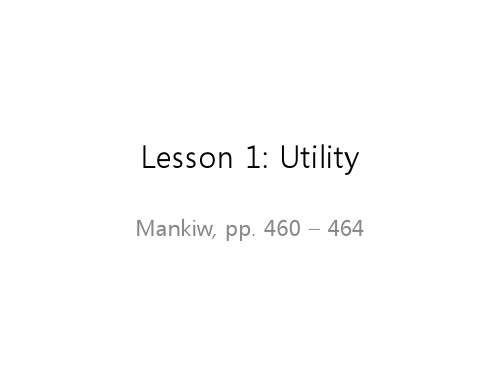
Utility Theory
• Utility is the degree of a preference an individual assigns to a state. If situa tion A is preferred to B, we say that A offers a higher utility than B.
Monotonicity examples
• Suppose values of y and x must be pos itive. In all of the following, y is a monotonic transformation of x:
–y –y –y –y = = = = 2x x+4 x^2 ln(x)
Monotonicity
• g(x) is a monotonic transformation of f(x) if, for all x1 and x2, f(x1) <, =, > f(x2) if and only if g(x1) <, =, > g (x2)
• In other words, monotonic transformat ions are order preserving. • Utility functions are equivalent to m onotonic transformations of themselve s
Branches of Economics
• Microeconomics is the study of how ho useholds and firms make decisions and how they interact in specific markets .
曼昆微观经济学经济学十大原理 英文版

教材(英文版):Principles of Economics, 7ed.
written by N. Gregory Mankiw
中文版:《经济学原理(微观经济学分册)》,梁小明、
梁砾译,北京大学出版社
参考书:《经济学原理学习指南》,大卫· 哈克斯著,梁小
民译,北京大学出版社;《曼昆<经济学原理(微观经济学 分册)>笔记和课后习题(含考研真题)详解》,圣才考研 网主编,中国石化出版社
万美元时,高中篮球明星科 比.布赖恩特(Kobe Bryant )决定不读大学而直接进入 职业篮球联盟( NBA )。
TEN PRINCIPLES OF ECONOMICS
11
Examples:
Choice A B C D E Revenue 200$ 150$ 180$ 201$ 200$ opportunity cost 201$ 201$ 201$ 200$ 201$
1
CHAPTER
1
Ten Principles of Economics (经济学十大原理)
Economics
PRINCIPLES OF
N. Gregory Mankiw
© 2015 CUFE
In this chapter, look for the answers to these questions:
society gets the most from its scarce resources
Equality:经济成果在社会成员中公平分配的特性 when
prosperity is distributed uniformly among society’s members.
Tradeoff: To achieve greater equality, income could be
中国人民大学财政金融学院金融学专业推荐阅读书目
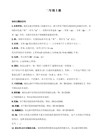
Benjamin M. Friedman& Frank H.Hahn
19、The Economics of Money, Banking and Financial Markets
Frederic S. Mishkin
39、Theory of International Trade﹡ Dixit A.K.&Norman V.
40、International Finance:Management, Markets, and Institutions
Prentice Hall
(四)证券投资
41、Fundamentals of Investment Appraisal Steve Lumby, Chris Jones
42、Modern Investment Theory Prentice Hall
43、Investment under Uncertainty﹡ Dixit A.K.&Pindyck R.S.
44、Investment Science﹡ David G. Luenberger
(五)公司财务
45、Fundamentals of Corporate Finance(Sixth Edition)
Stephen A. Ross, Randolph W. Westerfield, Bradford D. Jordan.
46、Principles of Corporate Finance Brealey & Myers
26、Dynamic Asset Pricing Theory﹡ Darrell Duffie
大学经济学英语教材推荐

大学经济学英语教材推荐In recent years, the study of economics has gained immense popularity among college students. With its wide range of applications and relevance to real-life situations, economics has become an essential subject for those pursuing a variety of career paths. As such, the demand for high-quality economics textbooks in English is on the rise. In this article, we will recommend several outstanding economics textbooks for university students. These textbooks are chosen based on their comprehensive coverage, clarity of content, and accessibility for non-native English speakers.1. "Principles of Economics" by N. Gregory Mankiw"Principles of Economics" is widely regarded as one of the most popular introductory economics textbooks. Written by renowned economist N. Gregory Mankiw, this textbook offers a balanced and clear introduction to economics concepts. It covers a wide range of topics, including microeconomics, macroeconomics, and international economics. The book presents complex ideas in a concise and accessible manner, making it suitable for both beginners and intermediate students.2. "Economics" by Paul Krugman and Robin WellsAuthored by Nobel laureate Paul Krugman and Robin Wells, "Economics" provides a modern and engaging approach to the subject. The textbook focuses on real-world examples and applications, enabling students to understand the relevance of economic theories in different contexts. It covers various economic principles, including supply and demand, marketstructures, and economic policy. The book also incorporates visual aids, such as graphs and charts, to enhance comprehension.3. "Macroeconomics" by Olivier Blanchard and David R. JohnsonFor students looking to delve deeper into macroeconomics, "Macroeconomics" by Olivier Blanchard and David R. Johnson is an excellent choice. This textbook offers a comprehensive analysis of macroeconomic theories and policies. It explores topics such as economic growth, inflation, unemployment, and fiscal policy. The authors provide clear explanations and use real-world examples to illustrate key concepts. The book also includes case studies and exercises to test students' understanding.4. "International Economics" by Paul Krugman and Maurice ObstfeldGlobalization has transformed the modern world, making international economics a crucial field of study. "International Economics" by Paul Krugman and Maurice Obstfeld provides a comprehensive understanding of international trade and finance. The textbook covers topics such as trade theories, exchange rates, and international capital flows. It incorporates case studies and data analysis to demonstrate the various challenges and opportunities in the global economy.5. "Managerial Economics" by William F. Samuelson and Stephen G. MarksFor students interested in the application of economics in business settings, "Managerial Economics" by William F. Samuelson and Stephen G. Marks is an ideal choice. This textbook combines economic theory withpractical decision-making techniques. It covers topics such as cost analysis, pricing strategies, and market structure analysis. The book also includes real-world case studies and examples to help students apply economic concepts to managerial situations.Overall, these recommended economics textbooks offer a comprehensive and accessible approach to the study of economics in English for university students. Whether you are a beginner or seeking a deeper understanding of specific economic concepts, these textbooks provide the necessary foundation to excel in the field of economics. Remember to choose the textbook that aligns with your academic goals and interests, and make the most of the valuable knowledge they offer.。
principles of economics 金融学入门课
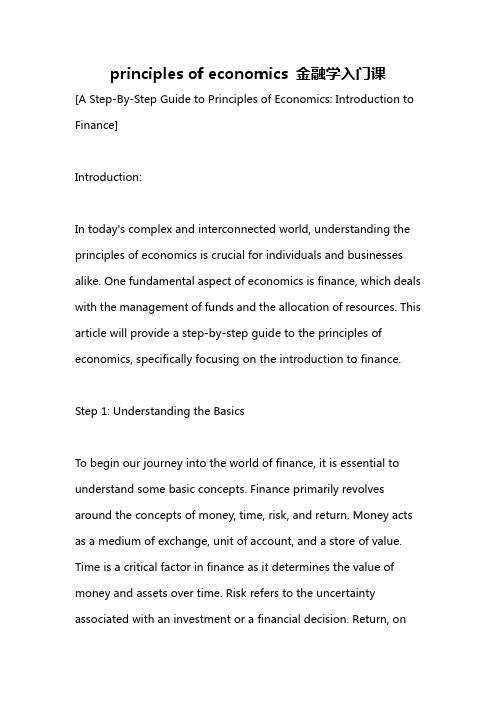
principles of economics 金融学入门课[A Step-By-Step Guide to Principles of Economics: Introduction to Finance]Introduction:In today's complex and interconnected world, understanding the principles of economics is crucial for individuals and businesses alike. One fundamental aspect of economics is finance, which deals with the management of funds and the allocation of resources. This article will provide a step-by-step guide to the principles of economics, specifically focusing on the introduction to finance.Step 1: Understanding the BasicsTo begin our journey into the world of finance, it is essential to understand some basic concepts. Finance primarily revolves around the concepts of money, time, risk, and return. Money acts as a medium of exchange, unit of account, and a store of value. Time is a critical factor in finance as it determines the value of money and assets over time. Risk refers to the uncertainty associated with an investment or a financial decision. Return, onthe other hand, is the gain or loss generated through an investment.Step 2: Exploring Financial MarketsFinancial markets play a crucial role in the world of finance. They are platforms where buyers and sellers meet to trade financial assets, such as stocks, bonds, and currencies. Understanding the various types of financial markets, including capital markets, money markets, and foreign exchange markets, is essential. Moreover, comprehending the functions of these markets, such as providing liquidity, allocating resources, and facilitating risk management, will enhance our understanding of finance.Step 3: Analyzing Financial StatementsFinancial statements are documents that provide an overview of a company's financial performance. There are three primary financial statements: the balance sheet, the income statement, and the cash flow statement. The balance sheet provides a snapshot of a company's assets, liabilities, and shareholders' equity at a specific point in time. The income statement shows a company's revenue,expenses, and profits over a given period. The cash flow statement demonstrates the inflow and outflow of cash from operating, investing, and financing activities. Analyzing these statements helps us assess a company's financial health and make informed investment decisions.Step 4: Evaluating Risk and ReturnUnderstanding the relationship between risk and return is crucial in finance. Generally, higher returns are associated with higher risks. Different investment options offer a varying degree of risk and potential return. Evaluating risk involves assessing factors such as volatility, market conditions, and regulatory changes. It also involves measuring the probability of a negative outcome. By comprehending the trade-off between risk and return, we can make informed investment decisions that align with our risk appetite and financial goals.Step 5: Studying Financial InstrumentsFinancial markets offer a wide range of instruments that enable individuals and businesses to raise capital or invest funds. Somecommon financial instruments include stocks, bonds, derivatives, and mutual funds. Understanding the characteristics, benefits, and risks associated with each instrument is crucial for effective financial decision-making. For instance, stocks represent ownership in a company and offer potential capital appreciation but come with market volatility. Bonds, on the other hand, are debt instruments issued by governments or corporations and offer fixed interest payments but carry credit risk.Step 6: Recognizing the Role of Financial InstitutionsFinancial institutions, such as banks, insurance companies, and investment firms, play a vital role in the functioning of the economy. They provide services like financing, risk management, and financial intermediation. Understanding the functions and importance of financial institutions helps us comprehend the overall financial system and its impact on economic growth and stability. Additionally, recognizing the role of central banks in controlling money supply, interest rates, and maintaining financial stability is crucial in understanding the broader economic context.Step 7: Applying Economic Principles to Personal FinanceLastly, understanding the principles of economics and finance should also be applied at an individual level. Personal finance encompasses budgeting, saving, investing, and managing debt. By applying economic principles such as opportunity cost, time value of money, and diversification, individuals can make informed financial decisions in their day-to-day lives. Moreover, understanding concepts like inflation, interest rates, and tax planning can help individuals plan for their future financialwell-being.Conclusion:The principles of economics and finance are essential for comprehending the complexities of the modern financial world. By following this step-by-step guide, we have explored the basics of finance, financial markets, financial statements, risk and return, financial instruments, financial institutions, and personal finance. With this foundation, individuals and businesses can make informed decisions, mitigate risks, and capitalize on opportunitiesin an ever-changing economic landscape.。
study guide for principles of economics 7th
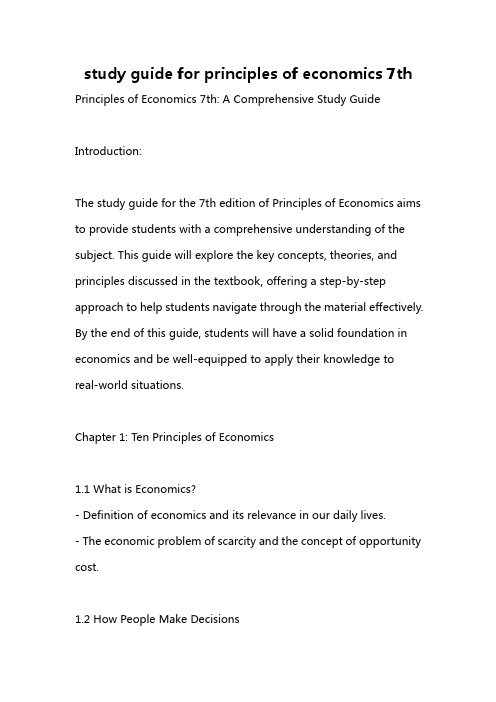
study guide for principles of economics 7th Principles of Economics 7th: A Comprehensive Study GuideIntroduction:The study guide for the 7th edition of Principles of Economics aims to provide students with a comprehensive understanding of the subject. This guide will explore the key concepts, theories, and principles discussed in the textbook, offering a step-by-step approach to help students navigate through the material effectively. By the end of this guide, students will have a solid foundation in economics and be well-equipped to apply their knowledge toreal-world situations.Chapter 1: Ten Principles of Economics1.1 What is Economics?- Definition of economics and its relevance in our daily lives.- The economic problem of scarcity and the concept of opportunity cost.1.2 How People Make Decisions- Introduction to the principles of rational decision-making. - The role of incentives and their impact on individual choices. - The concept of trade-offs and the decision-making process.1.3 How People Interact- Understanding the principles of market interaction.- The role of supply and demand in determining prices and quantities.- Different market structures and their implications.Chapter 2: Thinking Like an Economist2.1 The Economist's Approach- Introduction to the economic way of thinking.- Key assumptions and analytical tools used by economists. - The importance of models in economic analysis.2.2 Positive versus Normative Analysis- Distinguishing between positive and normative statements. - The role of value judgments in economic analysis.2.3 Production Possibilities Frontier- Understanding the concept of opportunity cost.- The shape and interpretation of the production possibilities frontier.- The role of technological advancements in expanding the production possibilities.Chapter 3: Interdependence and the Gains from Trade3.1 Comparative Advantage and Trade- The concept of comparative advantage and its role in international trade.- Understanding the gains from trade for both countries involved.3.2 The Market Forces of Supply and Demand- Introduction to the market forces of supply and demand.- Equilibrium and how it determines prices and quantities.Chapter 4: The Market Forces of Supply and Demand4.1 Elasticity and Its Applications- Understanding price elasticity of demand and supply.- Applications of elasticity in real-world scenarios, such as taxationand price controls.4.2 Price Ceilings and Price Floors- The concept of price ceilings and their effects on market outcomes.- The role of price floors in maintaining minimum prices and their consequences.Chapter 5: Elasticity and Its Applications5.1 The Costs of Production- Introduction to the different costs of production, including explicit and implicit costs.- Understanding the distinction between short-run and long-run costs.5.2 Different Market Structures- Analysis of different market structures, including perfect competition, monopolistic competition, oligopoly, and monopoly. - Identifying the characteristics, advantages, and disadvantages of each market structure.Chapter 6: Market Failures and Public Policy6.1 Public Goods and Common Resources- Understanding the concept of public goods and the free-rider problem.- The tragedy of the commons and its implications for resource usage.6.2 Externalities- Analysis of positive and negative externalities and their impact on market outcomes.- The role of government intervention in correcting externalities.Chapter 7: The Theory of Consumer Choice7.1 Utility Maximization- Introduction to utility and the concept of marginal utility.- The consumer's decision-making process considering budget constraints.7.2 Behavioral Economics- The influence of psychological and social factors on consumerbehavior.- Understanding biases and deviations from rationaldecision-making.Conclusion:By following this comprehensive study guide, students will have gained a solid understanding of the principles of economics. From the basic concepts of supply and demand to the intricacies of market structures and policy implications, this guide provides a step-by-step approach to ensure students grasp the subject matter. Economics is no longer an abstract concept but a practical tool to analyze real-world situations and make informed decisions.。
intermediate principles of economics
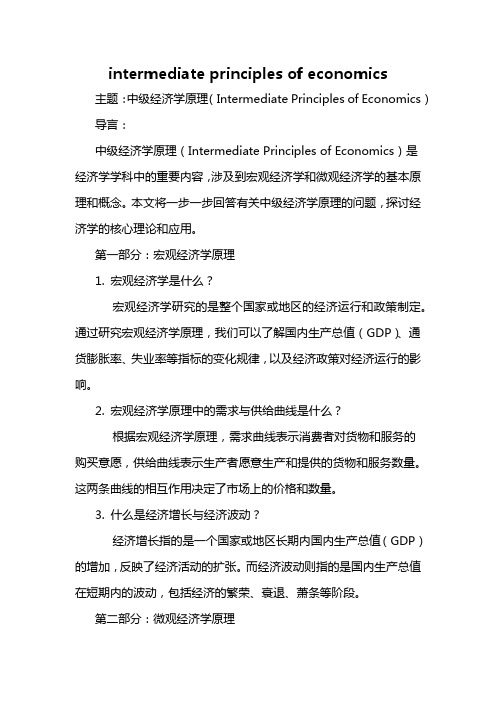
intermediate principles of economics主题:中级经济学原理(Intermediate Principles of Economics)导言:中级经济学原理(Intermediate Principles of Economics)是经济学学科中的重要内容,涉及到宏观经济学和微观经济学的基本原理和概念。
本文将一步一步回答有关中级经济学原理的问题,探讨经济学的核心理论和应用。
第一部分:宏观经济学原理1. 宏观经济学是什么?宏观经济学研究的是整个国家或地区的经济运行和政策制定。
通过研究宏观经济学原理,我们可以了解国内生产总值(GDP)、通货膨胀率、失业率等指标的变化规律,以及经济政策对经济运行的影响。
2. 宏观经济学原理中的需求与供给曲线是什么?根据宏观经济学原理,需求曲线表示消费者对货物和服务的购买意愿,供给曲线表示生产者愿意生产和提供的货物和服务数量。
这两条曲线的相互作用决定了市场上的价格和数量。
3. 什么是经济增长与经济波动?经济增长指的是一个国家或地区长期内国内生产总值(GDP)的增加,反映了经济活动的扩张。
而经济波动则指的是国内生产总值在短期内的波动,包括经济的繁荣、衰退、萧条等阶段。
第二部分:微观经济学原理1. 微观经济学是什么?微观经济学研究的是个体经济主体(如家庭、企业和市场)之间的经济决策和交互行为。
通过研究微观经济学原理,可以了解消费者如何做出购买决策、企业如何优化生产和定价,以及市场竞争对价格和数量的影响。
2. 供给和需求曲线如何确定价格和数量?根据微观经济学原理,供给曲线表示生产者愿意提供的货物和服务数量与价格的关系,需求曲线表示消费者愿意购买的货物和服务数量与价格的关系。
市场的价格和数量在供给和需求曲线的相互作用下,最终达到供给与需求平衡的状态。
3. 什么是边际效用和边际成本?边际效用指的是消费者从每多消费一单位产品中获得的额外满足程度,边际成本是指生产一单位产品所需要增加的额外成本。
经济学原理Principles of Economics.pptx
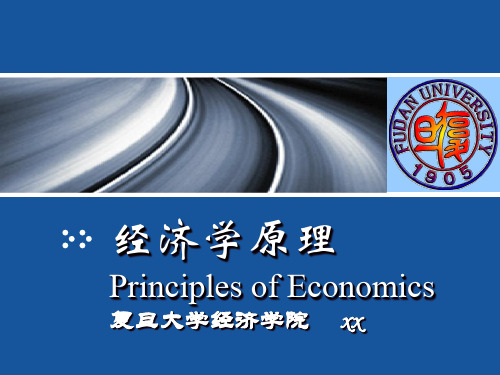
2019-11-12
P0
A MC
AC
Profit
C
B
D = AR
E
MR
O
Q0
谢谢聆听
Q
14
垄断厂商的短期均衡
• 几种短期均衡的情形 1) 获取超额利润的 $
短期均衡:P>AC 2) 超额利润为零的 短期均衡:P=AC
P0
MC AC
A
2019-11-12
D = AR
E
MR
O
Q0
谢谢聆听
谢谢聆听
5
垄断市场的特征
• 基本特征 1) 惟一的卖者(One seller - many buyers) 2) 无相近的替代品(One product(no good substitutes)) 3) 独自决定价格(Price maker) 4) 存在进入障碍(Barriers to entry) 5) 实行价格歧视(Price discrimination)
2;019如-11弹-12 性为-2,则价格将上谢谢升聆2听元。
31
主题内容
• 第一节 垄断市场的涵义与特征 • 第二节 垄断企业的行为与经济效率 第三节 垄断厂商的价格歧视
2019-11-12
谢谢聆听
32
价格歧视(差别价格)的含义
• 价格歧视(price discrimination)指同一产品以不同价 格出售,具体讲,就是同一成本的产品对不同顾客 规定不同价格,或者不同成本的产品对不同顾客规 定同一价格,或者同一成本的产品对同一顾客在不 同时间、不同地点、不同数量规定不同价格。
• 同一产品指经济意义上的同一产品。
– 由于运输费的不同导致同一型号彩电在不同地 方以不同价格出售,这就不属于价格歧视。
Theprinciplesofeconomics.经济学的原理(英译中)
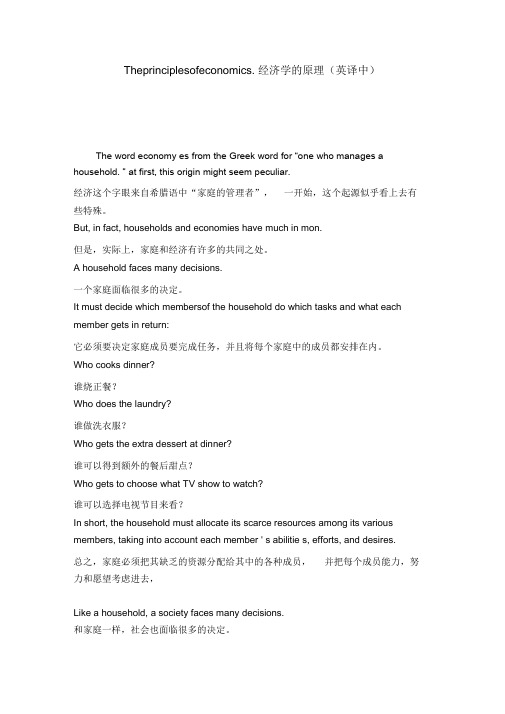
Theprinciplesofeconomics. 经济学的原理(英译中)The word economy es from the Greek word for “one who manages a household. ” at first, this origin might seem peculiar.经济这个字眼来自希腊语中“家庭的管理者”,一开始,这个起源似乎看上去有些特殊。
But, in fact, households and economies have much in mon.但是,实际上,家庭和经济有许多的共同之处。
A household faces many decisions.一个家庭面临很多的决定。
It must decide which membersof the household do which tasks and what each member gets in return:它必须要决定家庭成员要完成任务,并且将每个家庭中的成员都安排在内。
Who cooks dinner?谁烧正餐?Who does the laundry?谁做洗衣服?Who gets the extra dessert at dinner?谁可以得到额外的餐后甜点?Who gets to choose what TV show to watch?谁可以选择电视节目来看?In short, the household must allocate its scarce resources among its various members, taking into account each member ' s abilitie s, efforts, and desires.总之,家庭必须把其缺乏的资源分配给其中的各种成员,并把每个成员能力,努力和愿望考虑进去,Like a household, a society faces many decisions.和家庭一样,社会也面临很多的决定。
TEN PRINCIPLES OF ECONOMICS

TEN PRINCIPLES OF ECONOMICSTEN PRINCIPLES OF ECONOMICSEconomics: the study of how society manages its scarce resources.How People Make Decisions:1. People face trade off.. Efficiency: the property of society getting the most it can from its scarce resources.. Equality: the property of distributing economic prosperity fairly among the members of society.2. The cost of something is what you must give up.. Opportunity cost of some item is what we give up to get that item.3. Rational people think at margin.4. People respond to incentives.How People Interact:5. Trade can make everyone better off.6. Markets are the usually a good way to organize economic activity.. Market Economy: an economy that allocates resources through the decentralized decisions of many firms and households as they interact in markets for goods and services7. Governments can sometimes improve market outcomes.. Two Reasons for Government to Intervene in the Economy:. T o promote efficiency and.T o promote equity.. Market Failure: a situation in which a market left on its ability to allocate resources efficiently. Externality: the impact of one person’s actions on the well-beings of bystanders.. Market Power: the ability of a single economic actor (or small group of actors) to have a substantial influence on market priceHow the Economy as a Whole Works:8. A country’s standard of living depends on its ability to produce goods and services.. Productivity: the quantity of goods and services produced each hour of a work’s time.. Almost all variation in living standards is attributable to differences in countries’ productivity.9. Prices rise when the government prints too much Money. Main causes of INFLATION, an increase in the overall level of prices in economy.. When the governments create too much money, the value of money falls.10. Society faces a short-run trade-off between inflation and unemployment.. Two outcomes of print too much money:. Inflation;.A lower level of unemployment in short-term.. Phillips curve: a curve that shows the short-run trade-off between inflation and unemployment.. Economic policies push inflation and unemployment in opposite directions. THINKING LIKE A ECONOMICST1. The Circular-Flow Diagram. Circular-Flow Diagram is a visual model of the economy that shows how dollars flow through markets among households and firms.. Two Markets Included:- Market for goods and services;- Markets for Factors of Producti on: all inputs including labor, land, and capital.. In the market for goods and services, households are buyers, and firms are sellers.. In the market for the factors of production, households are sellers, and firms arebuyers.. The factors of production flow from households to firms, and the goods and services flow from firms to households.. Spending on goods and services flows from households to firms and income in the form of wages, rent and profit flows from firms to households.2. The Production Possibilities Frontier Model (PPF). The Production Possibilities Frontier is a graph that shows the combinations of output that economy can produce under given the available factors of production and available production technologies.. Economy can produce at any point on or inside the production possibilities frontier, but it cannot produce at points outside frontier according to its limited factor of production.Inside: inefficiency; at point: efficiency; outside: impossible unless improving factors of producti on.. Case Application: the opportunity cost of 100 cars is 200 computers. Because it must give up 200 computers to produce additional 100 cars.. The production Possibilities Frontier shows the trade-off between the production of different goods at given time, but it can change over time.- Application: an economic advance in the computer industry shifts the PPF outward.3. Microeconomics and Macroeconomics. Microeconomics is the study of how households and firms make decisions and how they interact in markets.. Macroeconomics is the study of economy-wide phenomena, including inflation, unemployment, and economic growth.4. Positive statements and Normative statements. Positive statements are descriptive. They make a claim about how the world is.. Normative statements are prescriptive. They make a claim about how the worldought to be.INTERDEPENDENCE AND THE GAIINS FROM TRADE. Absolute advantage: when comparing the productivity of one person, firm, or nation to that of another. The producer that requires a smaller quantity of inputs to produce a good is said to have an absolute advantage in producing that good.. Opportunity cost of some item is what we give up to get that item.. Comparative advantage: when describing the opportunity cost of two producers. The producer who gives up less of other goods to produce good X has the smaller opportunity cost of producing good X and is said to have a comparative advantage to producing it.. Import: Goods produced abroad and sold domestically are called imports . Export: Goods produced domestically and sold abroad are called exports. SUPPLY AND DEMAND1. Competitive Markets. The primary characteristics of perfect competition- The goods being offered for sale are all the same.- The buyers and sellers are so numerous that no single buyer or seller can influence the market price. Competitive market: A market in which there are many buyers and many sellers so that each has a negligible impact on the market price.. Quantity demanded of any good is the amount of the good that buyers are willing and able to purchase.2. Demand. Quantity demanded: the amount of a good that buyers are willing and able to purchase.- Move upward along with demand curve is called increase in quantity demanded.- Move downward along with demand curve is called decrease in quantity demanded.. Law of demand: Other things equal, when the price of a good raises, the quantitydemand of the good falls, and when the price falls, the quantity demand rises.3. Shifts in the Demand Curve. Shifts the demand curve to the right is called an increase in demand.. Shifts the demand curve to the left is called a decrease in demand. Income:. Normal Good: an increase in income leads to an increase in demand.. Inferior Good: an increase in income leads to a decrease in demand. Price of Related Goods:. Substitutes: two goods for which an increase in the price of one leads to anincrease in the demand for the other.. Complements: two goods for which an increase in the price of one leads to a decrease in the demand of the other.Number of Buyers:. Increase of number of buyers will lead to an increase of demand. Summary:VariableA Change in the Variable…PriceRepresent a movement along the demand curveIncomeShifts the demand curvePrices of Related GoodsShifts the demand curveT astesShifts the demand curveExpectationsShifts the demand curveNumber of BuyersShifts the demand curve4. Supply. Quantity supplied of any good or service is the amount that sellers are willing able to sell.- Move upward along with supply curve is called increase in quantity supplied.- Move downward along with demand curve is called decrease in quantity supplied.. Law of supply: Other things equal, when the price of a good rises, the quantity supplied of the good also rises, and when the price falls, the quantity supplied falls as well.5. Shift in Supply Curve. Shifts the supply curve to the right is called an increase in supply.. Shifts the supply curve to the left is called a decrease in supply.Input Prices. Increase in input prices, decrease in supplyT echnology. Improve well-advanced technology, increase in supplyExpectations. Good expectations of the future of certain products, increase in supply Number of Sellers. Increase in number of sellers, increase in supply.6. Supply and Demand together. Equilibrium: The point at which the supply and the demand curves intersect. This point called market’s equilibrium. The price at thisintersection is called the equilibrium price, and the quantity is called the equilibrium quantity.. The equilibrium price is sometime called the Market-Clearing Price.. Surplus: Suppliers are unable to sell all they want at the going price. A surplus sometimes called excess supply. (See p.77 figure 9)- Price is high; respond to cut their. Shortage: Demanders are unable to buy all they want at the going price. A shortage sometimes called excess demand. (See p.77 figure 9)- Price is low; respond to rise their price. Law of supply and demand: The price of any good adjusts to bring the quantity supplied and quantity demanded for that good into balance. Three steps to analyse changes in equilibrium1) Decide whether the event shifts the supply or demand curve2) Decide in which direction the curve shifts.3) Use the supply-and-demand diagram to see how the shift the equilibrium priceand quantity.ELASTICITY AND ITS APPLICATION. Elasticity: a measure of responsiveness of quantity demanded and quantity supplied to one of its determinants.1. Price Elasticity. Price elasticity of demand measures how much the quantity demanded responds to a change in price. Demand for a good is said to be elastic if the quantity demand responds substantially to changes in the price. Demand is said to be inelastic if the quantity demanded responds only slightly the change the pricePercentage change in quantity demandedPrice elasticity of demand = ---------------------------------------------------------Percentage change in price. Demand is inelastic when elasticity is less than 1; Demand is elastic when elasticity is greater than 1; if the elasticity is exactly 1, demand is said to have unit elasticity.. Elasticity is zero, demand is perfectly inelastic; Elasticity is ∞, demand is perfectly elastic.. More elastic, more flatter the demand curve; more inelastic, sharper the demand curve.Variables affect the elasticity of demand:When Calculate, it is a better way to use what is called Midpoint Method, that is: (Q2-Q1)/ [(Q2+Q1)/2]Price elasticity of demand = -------------------------------- (P2-P1)/ [(P2+P1)/2]. Availability of Close Substitutes: Goods with close substitutes tend to have more elastic demand because it is easier for consumer to switch from.. Necessaries VS Luxuries: Necessities tend to have inelastic demands, whereas luxuries have elastic demands.. Definition of the Market: Narrowly defined markets tend to have more elasticdemand than broadly defined markets.. Time Horizon: Goods tend to have more elastic demand over longer time horizon.T otal Revenue and the Price Elasticity of Demand. T otal Revenue: The amount paid by buyers and received by sellers of the good. In any market, total revenue is P × Q. When demand is inelastic, price and total revenue move in the same direction.. When demand is elastic, price and total revenue move in opposite direction.. If demand is unit elastic, total revenue remains constant when the price changes.2. Other Demand ElasticisesThe Income Elasticity of Demand. A measure of how much the quantity demanded of a good responds to consumer’s income.Percentage change in quantity demandedIncome elasticity of demand = -------------------------------------------------------Percentage change in income. Normal goods have positive income elasticity, while inferior goods have negative income elasticity.. Necessities tend to have small positive income elasticity, while luxuries tend to have large positive income elasticity.The Cross-Price Elasticity of Demand. A measure of how much the quantity demanded of one good respond to a change in the price of another good.Percentage change in quantity demanded of good 1Cross-price elasticity of demand = ---------------------------------------------------------Percentage change in the price of good 2. If two goods are substitutes, the cross-price elasticity of demand is positive;. If two goods are complements, the cross-price elasticity of demand is negative.3. Price Elasticity of Supply. A measure of how much the quantity supplied of a good responds to a change in the price of that good. Supply of good is said to be elastic if the quantity supplied responds substantially tochanges in the price. Supply is said to be inelastic if the quantity suppliedresponds only slightly to changes in the price.Percentage change in quantity suppliedPrice elasticity of supply = ---------------------------------------------------------Percentage change in the price. Supply is usually more elastic in the long run than in the short run.. Perfectly inelastic: when the supply curve is vertical.. Perfectly elastic: when the supply curve is infinity.. Elastic supply: elasticity is greater than 1.. Inelastic supply: elasticity is less than 1.. Unit elastic supply: elasticity equals 1.SUPPLY, DEMAND, AND GOVERNMENT POLICIES1. Price CeilingA legal maximum on the price at which a good can be sold.. When the government imposes a binding price ceiling on the competitive market, a shortage of the good arises, and sellers must ration the scarce goods among the large number of potential buyers.*(See more by studying the cases of Oil control and Rent contro l on pp.116-118.)2. Price Floor. Price floor: When the price is not allowed to fall below a particular level that is forced by government, this legislated minimum is called a price floor.. A binding price floor causes a surplus.*(See more by studying the cases of the minimum wage on pp. 121-122.)3. T axesT ax incidence is the manner in which the burden of a tax is shared among participants in a market.Summary:. A price ceiling is a legal maximum on the price of a good or service. An example is rent control. If the price ceiling is below the equilibrium price, the quantity demanded exceeds the quantity supplied. Because of the resulting shortage, sellers must in some way ration the good or service among buyers.. A price floor is a legal minimum on the price of a good or service. An example is the minimum wage. If the price floor is above the equilibrium price, the quantity supplied exceeds the quantity demanded. Because of the resulting surplus, buyers’ demands for the good or service must in some way be rationed among sellers.. When the government levies a tax on a good, the equilibrium quantity of the good falls. That is, a tax on a market shrinks the size of the market.. A tax on a good places a wedge between the price paid by buyers and the price received by sellers. When the market moves to the new equilibrium, buyers pay more for the good and sellers receive less for it. In this sense, buyers and sellers share the tax burden. The incidence of a tax does notdepend on whether the tax is levied on buyers or sellers.. The incidence of a tax depends on the price elasticity of supply and demand.The burden tends to fall on the side of the market that is less elastic because thatside of the market can respond less easily to the tax by changing the quantity bought or sold. CONSUMERS, PRODUCERS, AND THE EFFICIENCY OF MARKETS.1) Consumer Surplus. Willingness to Pay: the maximum amount that a buyer will pay for a good. . Consumer Surplus: the amount a buyer is willing to pay for a good minus the amount the buyer actually pays for it.Consumer surplus = Value to buyers – Amount paid by buyers. The area below the demand curve and above the price measures the consumer surplus in a market.. Consumer surplus is a good measure of economic well-being.2) Producer Surplus. Cost: the value of everything a seller must give up to produce a good.. Producer Surplus: the amount a seller is paid for a good minus the seller’s cost.Producer surplus = Amount received by sellers – Cost to sellers. The area below the price and above the supply curve measures the producer surplus in a market.. Producer surplus is a good measure of well-being of sellers.3) Market Efficiency. If an allocation of resources maximizes total surplus received by all members of society, we say that the allocation exhibits Efficiency.- Make the economic pie as bigger as possible!T otal surplus = Value to buyers – Amount paid by buyers+ Amount received bysellers – Cost to sellers.That isT otal surplus = Value to buyers – Cost to sellers.. Social Planner also care about Equity—the fairness of the distribution of well-being among the various buyers and sellers.- Divided the economic pie as fairly as possible!EquilibriumWhen Demand and Supply reach equilibrium:1) Free market allocates the supply of goods to the buyers who value them most highly, as measured by their willingness to pay.2) Free market allocates the demand for goods to the sellers who can produce them at least cost.3) Free market produces the quantity of goods that maximizes the sum of consumer and producer surplus.PriceThe T otal Surplus in a non-equilibrium point.Producer Surplus Consumer Surplus Quantity Supply Demand APPLICATION: THE COST OF TAXATION1. The Deadweight Loss of T axation. A tax on a good causes the size of the market for the good to shrink.. T axes cause deadweight losses because they prevent buyers and sellers from realizing some of the gains from trade.. The tax makes buyers and sellers worse off and the government better off. . The losses to buyers and sellers from a tax exceed the revenue raise by the government.2. The Determinants of Deadweight Loss. The greater the elasticity of supply and demand curve, the greater the deadweight loss of a tax.. Size of a tax grows larger; the deadweight loss grows larger;. Size of a tax grows larger; the tax revenue first rises, then falls. This relationship sometimes is called Laffer Curve.EXTERNALITIES. One cause of Market Failure, which is a situation in which a market left on its own fails to allocate resources efficiently.. Externality: the uncompensated impact of one person’s actions on the well-being of a bystander.. If the impact on the bystander is adverse, it is called a negative externality; if it is beneficial, it is called a positive externality.. Because buyers and sellers neglect the external effects of their actions when deciding how much to demand or supply, the market equilibrium is not efficient when there are externalities.Externalities and Market EfficiencyNegative ExternalitiesPositive Externality. Negative externalities lead to markets to produce a larger quantity than is socially desirable. Positive externalities lead markets to produce a smaller quantity than socially desirable.Summary:. The social cost is larger than the private cost.. Thus, QMARKET is larger than the socially optimal quantity, QOPTIMUM. . Reducing the production and consumption below the market equilibrium level raises total economic well-being.. What the government does is to Internalizing the Externality.. That is, altering incentives so that people take account of the external effects of their actions.. The social value is larger than the private value.. Thus, QMARKET is smaller than the socially optimal quantity, QOPTIMUM. . Increasing the production and consumption above the market equilibriumlevel raises total economic well-being.. What the government does is to Internalizing the Externality.T o remedy the problem, the government can internalize the externality by taxing goods that have negative externality and subsiding goods that have positive externalities.3. Private Solutions to Externalities. Coase Theorem: the proposition that if private parties can bargain without cost over the allocation of resources, they can solve the problem of externalities on their own.. Whatever the initial distribution of rights, the interested parties can always reach a bargain in which everyone is better off and the outcome is efficient. . Sometimes the interested parties fail to solve an externality problem because of transaction costs, the costs that parties incur in the process of agreeing and following through on a bargain.. Reaching an efficient bargain is especially difficult when the number of interested parties is large.4. Public Policies T oward ExternalitiesRegulation. Command and Control based policiesPigovian T axes and Subsidies. Market-based policies. Pigovian tax is a tax which enacted to correct the effects of a negative externality.. Compared with Regulation, T axes can reduce pollution more efficiently because people face incentives to reduce their pollution.Tradable Pollution permits. Selling pollution permits may be better than levying a Pigvian T ax, because government can reach any quantity controlled directly.PUBLIC GOODS AND COMMON RESOURCES1. The Different Kinds of GoodsIn thinking about the various goods in the economy, it is useful to group them according to two characteristics:. Excludability: the property of good whereby a person can be prevented form using it.. Rivalry: the property of a good whereby one person’s use diminishes other people’s use.Private GoodsRival Excludable Natural Monopolies Non-Rival ExcludableCommon Goods Rival Non-excludable Public Goods Non-Rival Non-excludable2. Public GoodsThe Free-Rider Problem:. A person who receives the benefit of a good but avoids paying for it.. Because public goods are not excludable, private market do not want tosupply them. If the government decides that the total benefits exceed the costs, it can provide the public goods and pay for it with tax revenue. Some important Public Goods:. National Defence; Basic Research; Fighting Poverty3. Common ResourcesTragedy of the Commons:. A parable that illustrates why common resources get used more than is desirable from the standpoint of society as a whole.. The tragedy of the Commons arises because of the externality.. Government can; reducing use of the common resources by regulation or taxes, or turn the common resource into a private good.THE COST OF PRODUCTION1. What is Cost?. T otal Revenue: the amount a firm receive for the sale of its output.. T otal Cost: the market value of inputs a firm uses in production.. Profit: T otal revenue minus total cost.. Explicit Costs: input costs that require an outlay of money by the firm.. Implicit Costs: input costs that do not require an outlay of money of money by the firm.. Economic Profit: T otal revenue minus total cost, including both explicit costs and implicit cost.. Accounting Profit: T otal revenue minus total cost, including only explicit costs rather than implicit costs.2. Production and CostsThe Production FunctionThe Production Function is the relationship between quantity of inputs used to make this good and quantity of outputs of that good.The Marginal Product is the increase in output arises from an additional unit of input.. The PF curve tends to be flatter, since with the growth of input, the productivity is decreasing.. The Slop of PF curve measures the Marginal Production.. Diminishing Marginal Product: the property whereby the marginal product of an input declines as the quantity of the input increases.Production FunctionSlop. Marginal Production Input Output T otal Cost Curve. A total-cost curve shows the relationship between the quantities of output produced and total cost of production.. TC curve gets steeper as the amount produced rises, whereas FC curve gets flatter.. Slop of TC curve measures the Marginal Cost. Output Cost Slop. Marginal Cost3. The Various Measures of Cost。
Chap_01 Principles of Economics
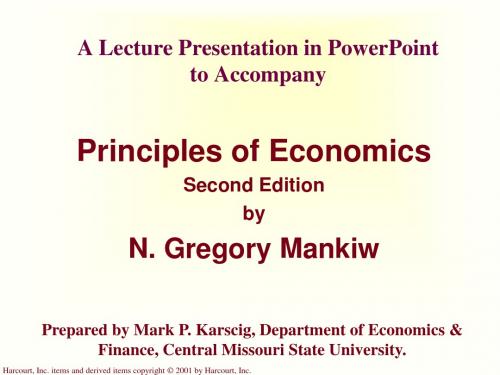
1. People face tradeoffs.
To get one thing, we usually have to give up another thing.
Guns v. butter Food v. clothing Leisure time v. work Efficiency v. equity Making decisions requires trading off one goal against another.
Harcourt, Inc. items and derived items copyright © 2001 by Harcourt, Inc.
Ten Principles of Economics
Chapter 1
Copyright © 2001 by Harcourt, Inc. All rights reserved. Requests for permission to make copies of any part of the work should be mailed to: Permissions Department, Harcourt College Publishers, 6277 Sea Harbor Drive, Orlando, Florida 32887-6777.
A household and an economy face many decisions:
Who
will work? What goods and how many of them should be produced? What resources should be used in production? At what price should the goods be sold?
- 1、下载文档前请自行甄别文档内容的完整性,平台不提供额外的编辑、内容补充、找答案等附加服务。
- 2、"仅部分预览"的文档,不可在线预览部分如存在完整性等问题,可反馈申请退款(可完整预览的文档不适用该条件!)。
- 3、如文档侵犯您的权益,请联系客服反馈,我们会尽快为您处理(人工客服工作时间:9:00-18:30)。
1WHAT’S NEW IN THE S EVENTH EDITION: There is an additional example about marginal benefits and marginal costs.LEARNING OBJECTIVES:By the end of this chapter, students should understand:that economics is about the allocation of scarce resources.that individuals face trade-offs.the meaning of opportunity cost.how to use marginal reasoning when making decisions.how incentives affect people’s behavior.why trade among people or nations can be good for everyone.why markets are a good, but not perfect, way to allocate resources.what determines some trends in the overall economy.CONTEXT AND PURPOSE:Chapter 1 is the first chapter in a three-chapter section that serves as the introduction to the text. Chapter 1 introduces ten fundamental principles on which the study of economics is based. In a broad sense, the rest of the text is an elaboration on these ten principles. Chapter 2 will develop how economists approach problems while Chapter 3 will explain how individuals and countries gain from trade. The purpose of Chapter 1 is to lay out ten economic principles that will serve as building blocks for the rest of the text. The ten principles can be grouped into three categories: how people make decisions, how people interact, and how the economy works as a whole. Throughout the text, references will be made repeatedly to these ten principles.KEY POINTS:1 TEN PRINCIPLES OF ECONOMICS2 ❖ Chapter 1/Ten Principles of Economics∙ The fundamental lessons about individual decisionmaking are that people face trade-offs among alternative goals, that the cost of any action is measured in terms of forgone opportunities, that rational people make decisions by comparing marginal costs and marginal benefits, and that peoplechange their behavior in response to the incentives they face.∙ The fundamental lessons about interactions among people are that trade and interdependence can be mutually beneficial, that markets are usually a good way of coordinating economic activity among people, and that the government can potentially improve market outcomes by remedying a market failure or by promoting greater economic equality.∙The fundamental lessons about the economy as a whole are that productivity is the ultimate source of improving living standards, that growth in the quantity of money is the ultimate source of inflation, and that society faces a short-run trade-off between inflation and unemployment.CHAPTER OUTLINE:I. IntroductionA. The word “economy” comes from the Greek word oikonomos meaning “one who manages ahousehold.”B. This makes some sense because in the economy we are faced with many decisions (just as ahousehold is).C. Fundamental economic problem: resources are scarce.D. Definition of scarcity : the limited nature of society’s resources.E. Definition of economics: the study of how society manages its scarce resources.Chapter 1/Ten Principles of Economics ❖3II. How People Make DecisionsA. Principle #1: People Face Trade-offs1. “There ain’t no such thing as a free lunch.” Making decisions requires trading one goal foranother.2. Examples include how students spend their time, how a family decides to spend its income,how the U.S. government spends tax dollars, and how regulations may protect theenvironment at a cost to firm owners.3. An important trade-off that society faces is the trade-off between efficiency and equality.a. Definition of efficiency: the property of society getting the most it can from itsscarce resources.b. Definition of equality: the property of distributing economic prosperityuniformly among the members of society.c. For example, tax dollars paid by wealthy Americans and then distributed to those lessfortunate may improve equality but lower the return to hard work and therefore reducethe level of output produced by our resources.d. This implies that the cost of this increased equality is a reduction in the efficient use ofour resources.4. Recognizing that trade-offs exist does not indicate what decisions should or will be made.B. Principle #2: The Cost of Something Is What You Give Up to Get It1. Making decisions requires individuals to consider the benefits and costs of some action.2. What are the costs of going to college?a. We should not count room and board (unless they are more expensive at college thanelsewhere) because the student would have to pay for food and shelter even if she werenot in school.b. We sh ould count the value of the student’s time because she could be working for payinstead of attending classes and studying.3. Definition of opportunity cost: whatever must be given up in order to obtain someitem.4 ❖Chapter 1/Ten Principles of EconomicsC. Principle #3: Rational People Think at the Margin1. Economists generally assume that people are rational.a. Definition of rational people: people who systematically and purposefully do thebest they can to achieve their objectives.b. Consumers want to purchase the goods and services that allow them the greatest levelof satisfaction given their incomes and the prices they face.c. Firm managers want to produce the level of output that maximizes the profits the firmsearn.2. Many decisions in life involve incremental decisions: Should I remain in school this semester?Should I take another course this semester? Should I study another hour for tomorrow’sexam?a. Definition of marginal change: a small incremental adjustment to a plan ofaction.b. Example: Suppose that you are considering calling a friend on your cell phone and themarginal benefit of the 10 minute call is $7.00. Your cell phone costs you $40 per monthplus an additional $0.50 per minute. You typically talk for $100 minutes and have amonthly bill of $90. If you consider the average cost of a call, you would decide that thebenefit of this 10 minute call does not exceed its cost ($9.00). However, the marginalcost of the call is only $5.00 so the marginal benefit of the call does outweigh itsmarginal cost. Cell phone users who have unlimited minutes (free at the margin) oftenmake long and frivolous phone calls.c. Suppose that flying a 200-seat plane across the country costs the airline $100,000, whichmeans that the average cost of each seat is $500. Suppose that the plane is minutesfrom departure and a passenger is willing to pay $300 for a seat. Should the airline sellthe seat for $300? In this case, the marginal cost of an additional passenger is very small.d. Another example: Why is water so cheap while diamonds are expensive? The marginalbenefit of a good depends on how many units a person already has. Because water isplentiful, the marginal benefit of an additional cup is small. Because diamonds are rare,the marginal benefit of an extra diamond is high.3. A rational decision maker takes an action if and only if the marginal benefit is at least aslarge as the marginal cost.D. Principle #4: People Respond to Incentives1. Definition of incentive: something that induces a person to act.2. Because rational people make decisions by weighing costs and benefits, their decisions maychange in response to incentives.Chapter 1/Ten Principles of Economics ❖5a. When the price of a good rises, consumers will buy less of it because its cost has risen.b. When the price of a good rises, producers will allocate more resources to the productionof the good because the benefit from producing the good has risen.3. Many public policies change the costs and benefits that people face. Sometimes policymakersfail to understand how policies alter incentives and behavior and a policy may lead tounintended consequences.4. Example: Seat belt laws increase the use of seat belts but lower the incentives of individualsto drive safely. This leads to an increase in the number of car accidents. This also leads to anincreased risk for pedestrians.5. Case Study: The Incentive Effects of Gasoline PricesIII. How People InteractA. Principle #5: Trade Can Make Everyone Better Off1. Trade is not like a sports contest, where one side gains and the other side loses.2. Consider trade that takes place inside your home. Your family is likely to be involved in tradewith other families on a daily basis. Most families do not build their own homes, make theirown clothes, or grow their own food.3. Countries benefit from trading with one another as well.4. Trade allows for specialization in products that countries (or families) can do best.6 ❖Chapter 1/Ten Principles of EconomicsChapter 1/Ten Principles of Economics ❖7B. Principle #6: Markets Are Usually a Good Way to Organize Economic Activity1. Many countries that once had centrally planned economies have abandoned this system andare trying to develop market economies.2. Definition of market economy: an economy that allocates resources through thedecentralized decisions of many firms and households as they interact in markets for goods and services.3. Market prices reflect both the value of a product to consumers and the cost of the resourcesused to produce it.4. When a government interferes in a market and prevents price from adjusting, household andfirm decisions become distorted.5. Centrally planned economies failed because they did not allow the market to work.6. FYI: Adam Smith and the Invisible Handa. Adam Smith’s 1776 work suggested that although individuals are motivated by self-interest, an invisible hand guides this self-interest into promoting society’s economic well-being.b. Smith’s insights are at the center of mode rn economics and will be analyzed more fully inthe chapters to come.C. Principle #7: Governments Can Sometimes Improve Market Outcomes1. The invisible hand will only work if the government enforces property rights.a. Definition of property rights: the ability of an individual to own and exercisecontrol over scarce resources.2. There are two broad reasons for the government to interfere with the economy: thepromotion of efficiency and equality.3. Government policy can improve efficiency when there is market failure.8 ❖Chapter 1/Ten Principles of Economicsa. Definition of market failure: a situation in which a market left on its own fails toallocate resources efficiently.4. Examples of Market Failurea. Definition of externality: the impact of one person’s actions on the well-being ofa bystander.b. Definition of market power: the ability of a single economic actor (or smallgroup of actors) to have a substantial influence on market prices.c. Because a market economy rewards people for their ability to produce things that otherpeople are willing to pay for, there will be an unequal distribution of economic well-being.5. Note that the principle states that the government can improve market outcomes. This is notsaying that the government always does improve market outcomes.IV. How the Economy as a Whole WorksA. Principle #8: A Country’s Standard of Living Depends on Its Ability to Produce Goods andServices1. Differences in living standards from one country to another are quite large.2. Changes in living standards over time are also great.3. The explanation for differences in living standards lies in differences in productivity.4. Definition of productivity: the quantity of goods and services produced by each unitof labor input.5. High productivity implies a high standard of living.6. Thus, policymakers must understand the impact of any policy on our ability to produce goodsand services.7. In the News: Why You Should Study Economicsa. Training in economics helps us to understand fallacies and to anticipate unintendedconsequences.b. This is an excerpt from a commencement address by Robert D. McTeer, Jr., the formerPresident of the Federal Reserve Bank of Dallas and describes why students should studyeconomics.B. Principle #9: Prices Rise When the Government Prints Too Much Money1. Definition of inflation: an increase in the overall level of prices in the economy.2. When the government creates a large amount of money, the value of money falls, leading toprice increases.Chapter 1/Ten Principles of Economics ❖93. Examples: Germany after World War I (in the early 1920s) and the United States in the1970s.C. Principle #10: Society Faces a Short-Run Trade-off between Inflation and Unemployment1. Most economists believe that the short-run effect of a monetary injection is lowerunemployment and higher prices.a. An increase in the amount of money in the economy stimulates spending and increasesthe quantity of goods and services sold in the economy. The increase in the quantity ofgoods and services sold will cause firms to hire additional workers.b. An increase in the demand for goods and services leads to higher prices over time.2. The short-run trade-off between inflation and unemployment plays a key role in the analysisof the business cycle.3. Definition of business cycle: fluctuations in economic activity, such as employmentand production.4. Policymakers can exploit this trade-off by using various policy instruments, but the extentand desirability of these interventions is a subject of continuing debate.5. This debate heat ed up during the early years of Obama’s presidency. The severe downturn inthe economy led policymakers to try to stimulate demand, but some feared that the endresult would be inflation.10 ❖Chapter 1/Ten Principles of EconomicsSOLUTIONS TO TEXT PROBLEMS:Quick Quizzes1. There are many possible answers.2. A country is better off by trading because trade allows more goods and services to be producedthrough specialization. Markets allow the “invisible hand” to guide self-interested individuals into promoting economic well-being. Economists believe that governments should enforce property rights and can improve on market outcomes when market failure occurs. Two common examples of market failures are market power and externalities.3. The three principles that describe how the economy, as a whole, works are: (1) a country’s standardof living depends on its ability to produce goods and services; (2) prices rise when the government prints too much money; and (3) society faces a short-run trade-off between inflation andunemployment. A co untry’s standard of living depends largely on the productivity of its workers, which in turn depends on the education of its workers and the access its workers have to thenecessary tools and technology. Prices rise when the government prints too much money because more money in circulation reduces the value of money, causing inflation. Society faces a short-run trade-off between inflation and unemployment that is only temporary. Policymakers have someshort-term ability to exploit this relationship using various policy instruments.Questions for Review1. Examples of trade-offs include time trade-offs (such as studying one subject over another or studyingat all compared to engaging in social activities) and spending trade-offs (such as whether to use your last 15 dollars to purchase a pizza or to buy a study guide for that tough economics course).2. To figure out the opportunity cost of a vacation to Disney World, you would include the monetarycosts of: admission, travel, souvenirs. You would also include the cost of time spent on vacation. The time cost depends on your next best use of that time; if it is staying home and watching TV, the time cost may be small, but if it is working an extra week hours at your job, the time cost is the money you could have earned. You would NOT include the costs of food and lodging unless they exceeded the costs you would have incurred had you not gone to Disney World. In that case, you would only include the additional costs, not the total costs of food and lodging.3. The marginal benefit of a glass of water depends on your circumstances. If you have just run amarathon or you have been walking in the desert sun for three hours, the marginal benefit is very high. But if you have been drinking a lot of liquids recently, the marginal benefit is quite low. The point is that even the necessities of life, like water, do not always have large marginal benefits.4. Policymakers need to think about incentives so they can understand how people will respond to thepolicie s they put in place. The text’s example of seat belt laws shows that policy actions can have unintended consequences. If incentives matter a lot, they may lead to a very different type of policy;for example, some economists have suggested putting knives in steering columns so that people will drive much more carefully! While this suggestion is silly, it highlights the importance of incentives.5. Trade among countries is not a game with some losers and some winners because trade can makeeveryone better off. By allowing specialization, trade between people and trade between countries can improve everyone’s welfare.6. The “invisible hand” of the marketplace represents the idea that even though individuals and firmsare all acting in their own self-interest, prices and the marketplace guide them to do what is good for society as a whole.7. The two main causes of market failure are externalities and market power. An externality is the effectof one person’s actions on the well-being of a bystander, such as from pollution or the creation of knowledge. Market power refers to the ability of a single person (or small group of people) to unduly influence market prices, such as in a town with only one well or only one cable television company.8. Productivity is important because a country’s standard of living depends on its ability to producegoods and services. The greater a country’s productivity (the amount of goods and services produced from each hour of a worker’s time), the greater its standard of living w ill be.9. Inflation is an increase in the overall level of prices in the economy. Inflation is caused by increasesin the quantity of a nation’s money.10. Inflation and unemployment are negatively related in the short run. Thus, reducing inflation entailscosts to society in the form of higher unemployment in the short run.Quick Check Multiple Choice1. a2. c3. b4. b5. d6. aProblems and Applications1. a. A family deciding whether to buy a new car faces a trade-off between the cost of the car andother things they might want to buy. For example, buying the car might mean they must giveup going on vacation for the next two years. Also, fuel efficient cars are more expensive butregular cars require spending more on gas. Smaller cars are less expensive, but bigger carsmean saving time by avoiding multiple trips.b. For a member of Congress deciding how much to spend on national parks, one trade-off isbetween parks and other spending items or tax cuts. If more money goes into the parksystem, that may mean less spending on national defense or on transportation. Or instead ofspending more money on the park system, taxes could be reduced. Another tradeoff whendeciding how much to spend on national parks is spending a small amount on a lot of parksor a larger amount on a single park.c. When a company president decides whether to open a new factory, the decision is based onwhether the new factory will increase the firm’s profits compared to other alternatives. Forexample, the company could upgrade existing equipment or expand existing factories. Thebottom line is: Which method of expanding production will increase profit the most?d. In deciding how much to prepare for class, a professor faces a trade-off between the valueof improving the quality of the lecture compared to other things she could do with her time,such as working on additional research or enjoying some leisure time.e. In deciding whether to go to graduate school, the student faces a trade-off between hispossible earn ings with a bachelor’s degree and the benefits of an increased education (suchas higher future earnings and greater knowledge). The student also faces the trade-offbetween spending time with family or on leisure and spending time studying. Also, thestudent may face the tradeoff between taking out student loans and buying a home or carwith a loan.2. When the benefits of something are psychological, such as going on a vacation, it is not easy tocompare benefits to costs to determine if it is worth doing. But there are two ways to think about the benefits. One is to compare the vacation with what you would do in its place. If you did not go on vacation, would you buy something like a new set of golf clubs? Then you can decide if you would rather have the new clubs or the vacation. A second way is to think about how hard you had to work to earn the money to pay for the vacation. You can then decide if the psychological benefits of the vacation were worth the psychological cost of working.3. If you are thinking of going skiing instead of working at your part-time job, the cost of skiing includesits monetary and time costs, which includes the opportunity cost of the wages you are giving up by not working. If the choice is between skiing and going to the library to study, then the cost of skiing is its monetary and time costs including the value of time spent studying.4. If you spend $100 now instead of saving it for a year and earning 5 percent interest, you are givingup the opportunity to spend $105 one year from now.5. The fact that you have already sunk $5 million is not relevant to your decision anymore, because thatmoney is gone. What matters now is the chance to earn profits at the margin. If you spend another $1 million and can generate sales of $3 million, you’ll earn $2 million in marginal profit, so you should do so. You are right to think that the project has lost a total of $3 million ($6 million in costs and only $3 million in revenue) and you should not have started it. However, if you do not spend theadditional $1 million, you will not have any sales and your losses will be $5 million. So what matters here is trying to minimize your loss. In fact, you would pay up to $3 million to complete development;any more than that, and you will not be increasing profit at the margin.6. a. The provision of Social Security benefits lowers an individual’s incentive to save for retirement.The benefits provide some level of income to the individual when she retires. This means that the individual is not entirely dependent on savings to support consumption through the years inretirement.b. Since a person gets fewer after-tax Social Security benefits the greater her earnings are, there isan incentive not to work (or not work as much) after age 65. The more you work, the lower your after-tax Social Security benefits will be. Thus, the taxation of Social Security benefitsdiscourages work effort after age 65.7. a. When welfare recipients have their benefits cut off after two years, they have a greater incentiveto find jobs than if their benefits were to last forever.b. The loss of benefits means that someone who cannot find a job will get no income at all, so thedistribution of income will become less equal. But the economy will be more efficient, becausewelfare recipients have a greater incentive to find jobs. Thus, the change in the law is one thatincreases efficiency but reduces equality.8. a. E fficiency: The market failure comes from the market power of the cable TV firm.b. Equityc. Efficiency: An externality arises because secondhand smoke harms nonsmokers.d. Efficiency: The market failure occurs because of Standard Oil’s market power.e. Equityf. Efficiency: There is an externality because of accidents caused by drunk drivers.9. a. If everyone were guaranteed the best healthcare possible, much more of our nation’s outputwould be devoted to medical care than is now the case. Would that be efficient? If you believethat doctors have market power and restrict health care to keep their incomes high, you mightthink efficiency would increase by providing more healthcare. But more likely, if the government mandated increased spending on healthcare, the economy would be less efficient because itwould give people more healthcare than they would choose to pay for. From the point of view of equality, if poor people are less likely to have adequate healthcare, providing more health carewould represent an improvement. Each person would have a more equal slice of the economicpie, though the pie would consist of more healthcare and less of other goods.b. When workers are laid off, equality considerations argue for the unemployment benefits systemto provide them with some income until they can find new jobs. After all, no one plans to be laidoff, so unemployment benefits are a form of insurance. But there is an efficiency problem why work if you can get income for doing nothing? The economy is not operating efficiently if peopleremain unemployed for a long time, and unemployment benefits encourage unemployment. Thus, there is a trade-off between equality and efficiency. The more generous unemployment benefitsare, the less income is lost by an unemployed person, but the more that person is encouraged to remain unemployed. So greater equality reduces efficiency.10. Because average income in the United States has roughly doubled every 35 years, we are likely tohave a better standard of living than our parents, and a much better standard of living than ourgrandparents. This is mainly the result of increased productivity; an hour of work produces more goods and services than it used to. Thus, incomes have continuously risen over time, as has the standard of living.11. If Americans save more and it leads to more spending on factories, there will be an increase inproduction and productivity, because the same number of workers will have more equipment to work with. The benefits from higher productivity will go to both the workers, who will get paid morebecause they are producing more, and the factory owners, who will get a return on their investments.There is no such thing as a free lunch, however, because when people save more, they are giving up spending. They get higher incomes at the cost of buying fewer goods.12. When gover nments print money, they impose a “tax” on anyone who is holding money, because thevalue of money is decreased.。
